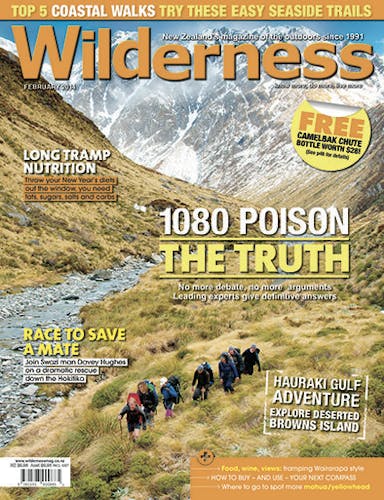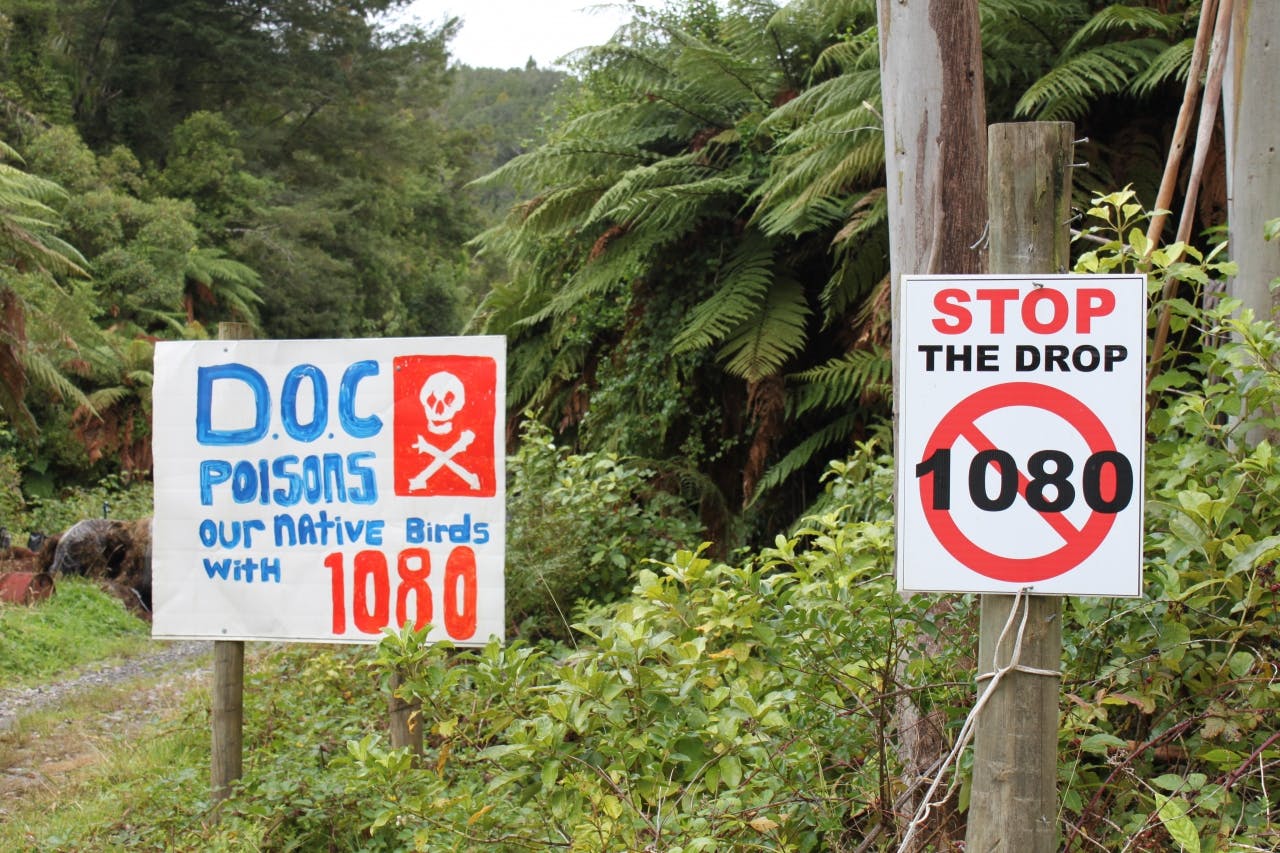No more myths. No more one-sided comments. Matthew Pike speaks to independent experts who tell us what we now know about this much-discussed toxin…
Since arriving in New Zealand more than two years ago the 1080 argument has fascinated me. It stirs emotion like few other topics. It’s the Kiwi equivalent of the US gun law debate or the asylum seeker issue in Australia.
I first encountered it on my travels with a sign on a gate which read ‘1080 kills everything’. Being new to the country I had no idea what this meant and couldn’t work out why this particular number could be destructive.
But it wasn’t long before I encountered it again. Soon, a DOC employee on the West Coast was telling me not to drink water from a tap because it’s full of poison. Then a pilot on a scenic flight spent most of the journey in a rage telling me that anti-1080 protesters were killing the native birds.
No-one I spoke to sat on the fence. They were for it or against it with the sort of passion usually spared for Rugby World Cups.
Researching the issue on the internet I find apocalyptic arguments for what will happen if we use it and arguments of equally dismal outcomes if we don’t. I see emotive videos of animals and birds dying slowly and in pain. I see tears and fury as people discuss the topic.
Both sides contain people with confidence and certainty over their arguments. And the arguments, if you believe them, instil fear.
So what can you believe? Instead of hearing each side of the story, I decided to speak to independent experts. I’ve been careful to choose people who represent neither side of the argument to gather a conclusive, informed and unbiased response to the key arguments.
I’ve put some of the most commonly held beliefs to the experts so we can dispel the myths once and for all and focus on the facts of 1080…
Dr Jan Wright is the Parliamentary Commissioner for the Environment. This body represents parliament, not the Government, so is therefore independent. Dr Wright’s job is to advise MPs on environmental issues..
1 It kills / has killed native birds (including kiwi and kea)
“Individuals from 19 species of native birds and 13 species of introduced birds have been found dead after aerial 1080 drops. Most of these recorded bird deaths were associated with only four operations 35 years ago that used poor quality carrot baits with many small fragments.
“Although it is now infrequent, individual aerial 1080 operations can still sometimes affect local bird populations if not carried out with sufficient care. One relatively recent case is the death of 7 out of 17 monitored kea from 1080 poisoning following an aerial operation in May 2008 in South Westland.
“But the key question is how the bird population responds after the 1080 operation through increased breeding success. Whio, kererū, kiwi, kea tomtits, robins, kākāriki and mōhua have all responded well to aerial 1080 operations, with increased chick and adult survival, and increases in population size.
“There are no recorded cases where kiwi have been killed by 1080.”
2 It has killed hundreds / thousands of dogs and farm animals.
“Since 2007, there have been eight confirmed cases of dogs being poisoned by 1080. The two most common poisonings of dogs are from anti-coagulant rat poisons and slug baits (note 134 in the report). Under current practices for using 1080, instances of dogs being poisoned are rare.”
3 It’s a particularly inhumane way to kill an animal and we should research more humane methods of pest control
“The National Animal Welfare Advisory Committee (NAWAC) recently commissioned a report that found 1080 to be a moderately humane pest control technique. The report also considered other pest control techniques used in New Zealand. Anti-coagulant poisons, for instance, are extremely inhumane.”
4 Why can’t we just use traps / hunters to control pests?
“Traps and other methods can be effective in small and easily accessible areas, but are not as effective (or as cost-effective) as 1080 in large and inaccessible areas. In addition, ground control methods cannot effectively control the rapidly growing populations of rats and stoats that occur after trees ‘mast’ and produce huge numbers of seeds.”
5 It’s only really used in New Zealand. Other countries have banned it. Why would it only be used here?
“Several other countries use 1080 for pest control, including Australia. In Western Australia, it is used over hundreds of thousands of hectares to control foxes, cats and wild dogs.”
6 There hasn’t yet been enough research into its effectiveness and potential harm
“There is a large body of research on 1080 in New Zealand and in other countries. It was on the basis of this research – much of which is referred to in her report, that I reached my conclusions about the effectiveness and safety of 1080. Research has been carried out by scientists from a range of organisations, including universities, research institutes and government agencies, in both New Zealand and around the world.”
7 It continues to remain in water supplies and soil, which could harm humans, animals and plants
“Once in water, 1080 is biodegraded into non-toxic by-products within two to six days, although the breakdown rate is slower in colder conditions. From September 1990 to February 2011, 2,537 water samples were tested, with traces of 1080 found in 86 of the samples. None of these 86 samples had been taken from a drinking water supply. The highest recorded concentration in a water sample following a 1080 operation is 9 parts per billion. At this concentration an adult would need to drink thousands of litres of water at one time to risk death.
“1080 will be significantly broken down in soil in one to two weeks under favourable conditions. In extremely dry and cold conditions, 1080 may remain in baits for several months. Rainfall will leach 1080 from baits left lying on soil and then dilute it down to undetectable levels – often faster than bacterial breakdown will. Concentrations of 1080 in soil and leaf litter following three aerial 1080 operations were measured in a field study. Very low concentrations of 1080 were recorded in 6 out of 118 soil samples. Low concentrations of 1080 were found in leaf litter in two of the three study sites, with the highest level recorded hundreds of times lower than that required to kill native insects such as ants and wētā.
“The highest concentrations of 1080 recorded in plants, animals and fish would require an adult to eat unusually large amounts before risking death – for example, 9 tonnes of pūhā, 5 tonnes of eel, 100 kg of venison.”
8 Humans have been killed / made ill from the poison
“There has been one case in New Zealand where this has occurred, and it appears a possum hunter died in the 1960s after eating 1080-laced jam bait – a bait now illegal to use – that was present in his home.”
9 It kills deer / pigs and other mammals commonly hunted in NZ
“Wild deer may eat baits directly, and pigs may eat baits or the carcasses of animals that have eaten baits. The proportion of the deer population that is killed in any operation depends on a number of factors, including the type of bait that is used, whether pre-feeding with non-toxic baits is carried out, and at what time of year the operation occurs.
“For a period of time after a 1080 operation, it is illegal to commercially harvest food from the area, and this period must be clearly stated on signs and public notices. The withholding period for aerial 1080 is based on a minimum period of six months plus an additional period based on the length of time baits and poisoned possum carcasses take to break down at the site. 1080 has not been used in recent times over the vast majority of the country where deer and other game species live.”








